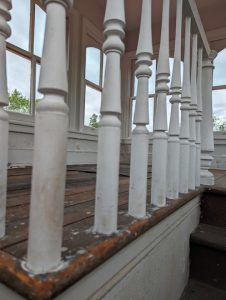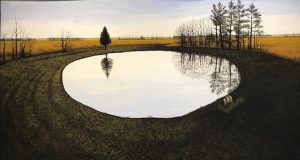Note: This is the first part of a series that will follow as Painter’s Folly in Chadds Ford is restored, updated, and converted into a space celebrating both the past and future of art in the Brandywine Valley. Each article will explore a different aspect of the location and the renovation process, from its history to its use as artistic inspiration to its new purpose.
The Brandywine Tradition is wide-ranging, its inspiration and history spread through every nook and corner of the Brandywine Valley. But if you were to look for its soul, there is an argument to be made that it resides in Painter’s Folly, that gorgeous old home hidden behind trees along Baltimore Pike in Chadds Ford. More than simply a house or an example of Italianate architecture, it is a place where art history has returned again and again. Now, Chadds Ford looks to bring that grand tradition back, as plans to turn the home into a mixture of artist studios and venue space take shape.

While it has been the home of and inspiration for some of the most famous artists of the Brandywine Valley, Painter’s Folly got its name, funnily enough, from a family with no connection to art. Samuel Painter emigrated to America at the turn of the 17thcentury, settling first in Philadelphia and then Birmingham Township. His prolific family is the reason Painter’s Crossing is so named today. Homes built by the family dot the landscape, many with celebrated histories of their own.
Samuel Painter, a descendant of their namesake, chose a spot on a hill next to the rolling fields where the Battle of the Brandywine had taken place to build his own home in 1857. As the Italianate architecture rose to dominate the landscape, neighbors disparagingly began referring to the home as
“Painter’s Folly” and the name stuck. The home certainly is an interesting style compared to local architecture, and today is known as one of the finest examples of Italianate architecture in the area.
Painter’s Folly was sold to various owners for about a century, from 1870 to the 1970s, and at times was used as a private residence and a doctor’s office. The home would be rented to another descendant of the original Painter family, Howard Pyle, around the turn of the 19th century. There he founded the Brandywine Tradition of art and taught painters such as N. C. Wyeth, Frank E. Schoonover, Harvey Dunn, and Clifford Ashley, among many others who would go on to have successful careers in the art world. N. C. Wyeth would be inspired to move to Chadds Ford himself and raise his family there, including his celebrated son, Andrew Wyeth.

Andrew Wyeth grew up visiting Painter’s Folly with his father. Throughout his career, he returned, whether to the home itself or to the surrounding grounds and the Brandywine Battlefield next door. It was on just such a visit that he ran into the newest owners of the home, George and Helen Sipala, soon after they had settled there in 1974. It was to turn into a long and close friendship, with the Sipalas not only becoming confidantes of Wyeth but inspirations and models as well.

Wyeth would paint many of his well-known works from his later career at Painter’s Folly. The widow’s walk, a standard decorative feature of Italian architecture, would feature prominently. At Painter’s Folly, the widow’s walk is enclosed with arched windows, more akin to the Italianate cupola than the open walkways seen on many New England homes (and supposedly haunted by many of those eponymous widows, still walking back and forth, waiting for their sea-captain husbands to return home). Paintings featured the widow’s walk both from exterior perspectives and from the interior, where Wyeth took advantage of the natural light to highlight his models and the surrounding landscape.
Painter’s Folly is a gem both in terms of its structure and its prominent place in art history. As it begins to evolve yet again, preparing to welcome new artists of all traditions, we will look back at its history, follow plans to restore its grandeur while creating an accessible place for all, and see what its future holds.
About Victoria Rose
Victoria Rose (she/her) is an editor, writer, avid reader, self-described geek, and fan of all things creative. Her passion for words has led to her current career as a freelance editor, and she is the owner of Flickering Words, an editing service. When not wielding a red pen (or cursor), she loves reading books of all genres, playing video, board, and word games, baking ridiculous creations to show off on the internet, or enjoying the gorgeous outdoors. She is a board member of the West Chester Film Festival and part of the Thirsty Monsters, a team of streamers from around the world who fundraise for various charities supporting LGBTQIA+ and accessibility rights. She can be found online @WordsFlickering or the Brandywine Art Guide @BrandywineArtGuide.
- Web |
- More Posts(113)




Comments